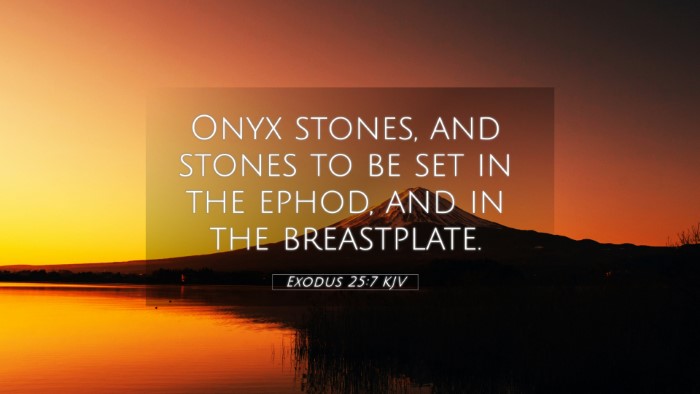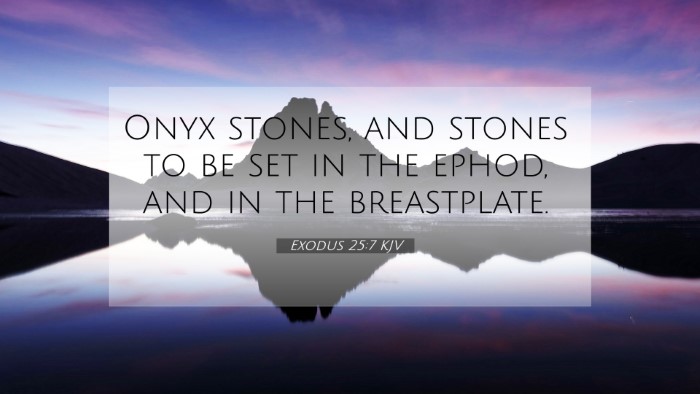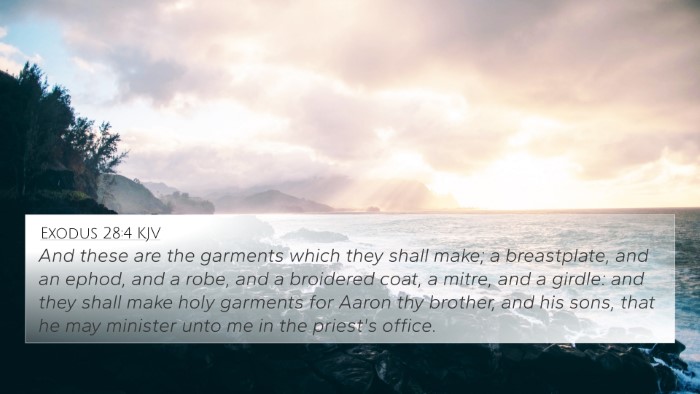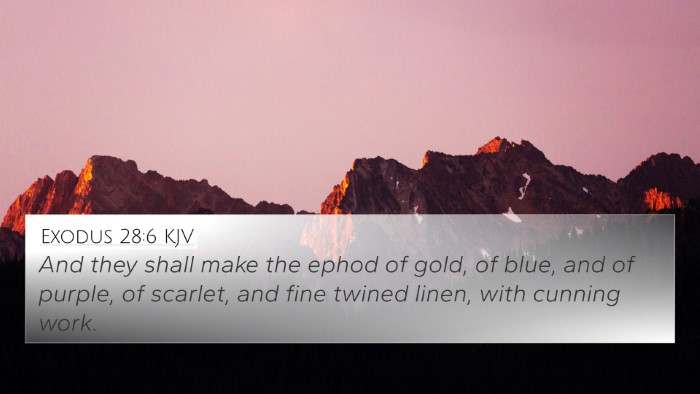Understanding Exodus 25:7
Exodus 25:7 states: "And oxen, and rams, and he goats, and with all the firstlings of the herd and of the flock." This verse is part of God's instructions to Moses regarding the materials needed for the construction of the Tabernacle, a portable sanctuary for worship during the Israelites' journey through the wilderness. The specific mention of animals emphasizes the sacrificial system and the role of offerings in demonstrating devotion and obedience to God.
Exegesis and Commentary
This verse draws deep insights from renowned public domain commentaries such as those by Matthew Henry, Albert Barnes, and Adam Clarke:
- Matthew Henry's Commentary:
Henry explains that the inclusion of various animals for offerings signifies the richness of God's provision and the necessary sacrifices required for atonement and worship. This verse demonstrates that worship must be supported by tangible expressions of faith.
- Albert Barnes' Notes:
Barnes highlights the significance of the specific animals listed. Each type of animal represents different aspects of life in ancient Israel and conveys the idea that worship encompasses all facets of one's being—wealth, livelihood, and community.
- Adam Clarke's Commentary:
Clarke interprets the verse as a reminder of the sacrificial nature of approaching God. He points out that these animals can also symbolize different denominations of offering, as each species had its own prescribed use in various forms of worship and ritual.
Cross-References for Exodus 25:7
Several verses provide a deeper understanding of the themes presented in Exodus 25:7. Here are 10 notable Bible cross-references:
- Exodus 12:5: "Your lamb shall be without blemish, a male of the first year. You may take it from the sheep or from the goats."
- Leviticus 1:3: "If his offering is a burnt sacrifice of the herd, let him offer a male without blemish; he shall offer it of his own free will at the door of the tabernacle of meeting before the Lord."
- Leviticus 3:1: "When his offering is a sacrifice of peace offering, if he offers it of the herd, whether male or female, he shall offer it without blemish before the Lord."
- Hebrews 9:22: "And according to the law almost all things are purified with blood, and without shedding of blood there is no remission."
- 1 Peter 1:19: "But with the precious blood of Christ, as of a lamb without blemish and without spot."
- Psalm 50:10-11: "For every beast of the forest is Mine, and the cattle on a thousand hills. I know all the birds of the mountains, and the wild beasts of the field are Mine."
- Isaiah 1:11-12: "'To what purpose is the multitude of your sacrifices to Me?' Says the Lord. 'I have had enough of burnt offerings of rams and the fat of fed cattle...'"
- Romans 12:1: "I beseech you therefore, brethren, by the mercies of God, that you present your bodies a living sacrifice, holy, acceptable to God, which is your reasonable service."
- Malachi 1:8: "And when you offer the blind as a sacrifice, is it not evil? And when you offer the lame and sick, is it not evil? Offer it then to your governor! Would he be pleased with you?"
- Matthew 5:23-24: "Therefore, if you bring your gift to the altar, and there remember that your brother has something against you, leave your gift there before the altar, and go your way; first be reconciled to your brother."
Thematic Connections
This verse serves as a cornerstone for various themes that run throughout the Bible:
- The Sacrificial System: The offerings and sacrifices required in the Old Testament set the stage for the ultimate sacrifice of Christ in the New Testament.
- The Importance of Worship: How one worships is critical in both testaments; thus, proper offerings are emphasized.
- God's Provision: The mention of animals pertains to God's continuous provision for His people.
Conclusion
Exodus 25:7 encapsulates essential aspects of worship through the lens of sacrificial offerings. By utilizing biblical cross-references, one can explore deeper interconnections and thematic ties that enhance our understanding of the scripture. As we navigate these verses, we gain insights into historical context, theological significance, and practical applications for our lives today.
In essence, the verse invites believers to reflect on their mode of worship and the holistic nature of sacrificial living as a response to God’s grace and mercy.




